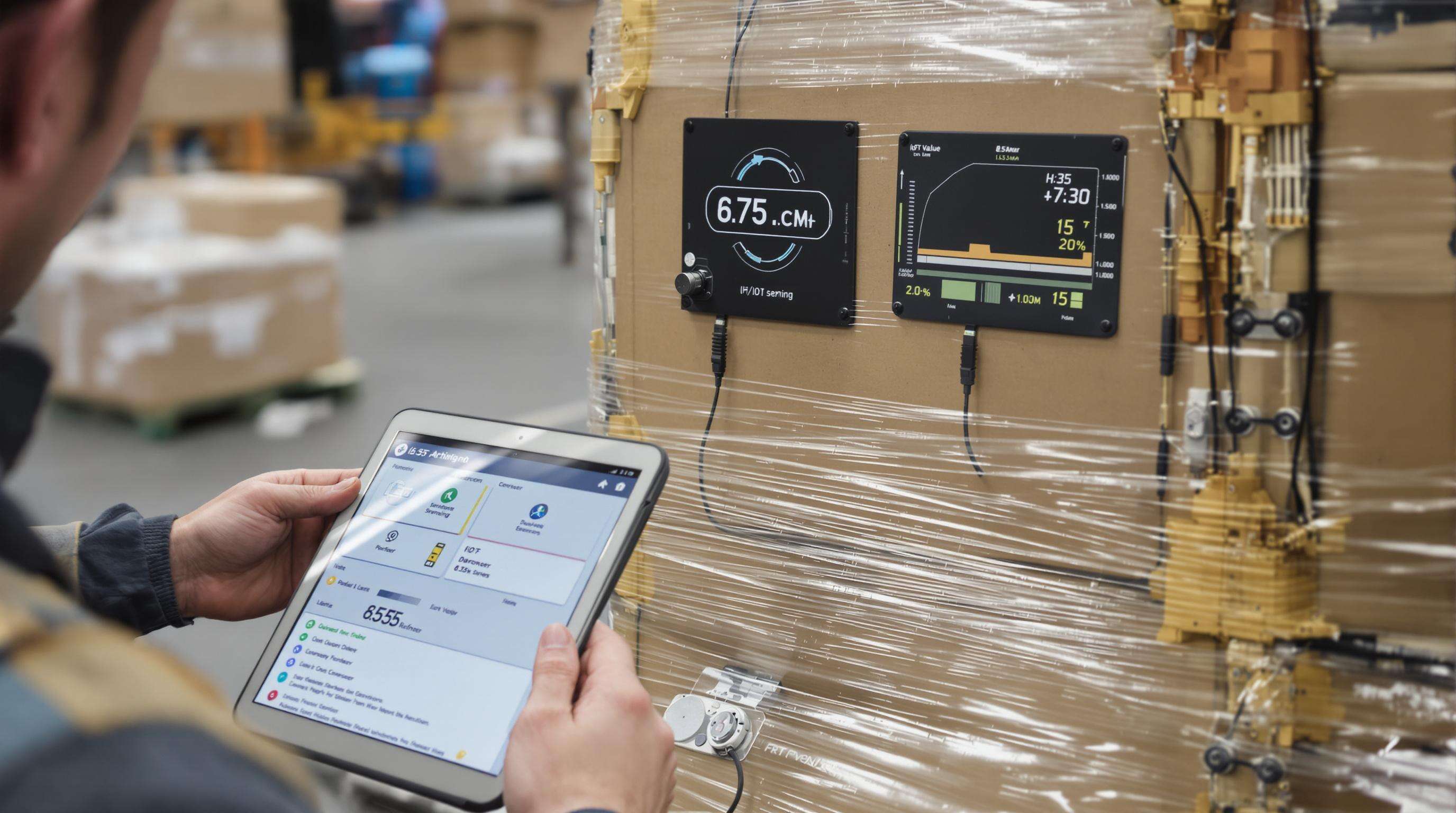On-Time Delivery Excellence Through Integrated Logistics Technology In United Road Logistics Operations
Leading logistics providers achieve industry-leading reliability through integrated technology stacks that synchronize every operational layer. By combining IoT-enabled visibility tools with predictive analytics, these systems enable 98.7% on-time delivery rates while adapting to shifting supply chain conditions in real time.
Real-Time Tracking and a 98.7% On-Time Delivery Rate
Today's logistics systems pull information from GPS devices, weight sensors on moving vehicles, and various traffic data sources to keep tabs on shipments as they move. With this detailed level of oversight, logistics managers can often find alternate routes when ports get backed up or bad weather hits an area. Some independent research actually found these smart routing capabilities cut down late deliveries by about a third according to a report published last year in Logistics Tech Review. Most companies see their operations hit around 98.7% reliability thanks to constant improvements made possible when real time tracking info gets fed back into the scheduling software that tells drivers where to go next.
Predictive Dispatching via Unified Logistics Platforms
Machine learning models analyze historical lanes, carrier performance patterns, and facility throughput rates to generate optimal dispatch plans. During the 2023 holiday season, companies using predictive dispatching maintained 96.4% on-time rates despite a 22% surge in volume, outperforming reactive operators by 19 percentage points.
Case Study: Reducing Automotive Delivery Delays by 40%
When a premium auto manufacturer faced chronic parts delivery delays, logistics engineers implemented:
- Telematics-integrated load boards matching shipments to carrier capabilities
- Dynamic ETA adjustments based on real-time road restrictions
- Automated detention charge calculations to incentivize faster turnaround
These changes reduced average transit times from 8.2 to 4.9 days while cutting detention costs by $218,000 annually.
Aligning KPIs with Delivery Performance for Consistent Results
Top performers tie 63% of carrier compensation to measurable service metrics like:
| KPI | Target | Weight |
|---|---|---|
| On-time pickup | 98% | 25% |
| Damage-free delivery | 99.5% | 35% |
| Documentation accuracy | 100% | 15% |
This alignment drives behavioral changes that cascade through the logistics network.
Meeting Rising Customer Expectations with Proactive Logistics
Shippers now expect:
- 15-minute delivery windows instead of 4-hour blocks
- Instant access to digital proof-of-delivery
- Predictive delay notifications via SMS/email
According to Gartner's 2024 Logistics Trends Report, companies offering proactive status updates see 41% higher customer satisfaction scores than competitors relying on traditional tracking methods.
AI-Powered Demand Forecasting for Smarter Capacity Planning

Machine learning plays a big role in how United Road handles their logistics operations these days. The system looks at past shipping data, what's happening economically, and seasonal patterns to get things right. According to the 2024 Logistics Technology Report, this smart approach cuts down on forecasting mistakes by about 32% when compared with old school methods. What does that mean practically? Trailer utilization hits around 98.5%, which is pretty impressive. When the system spots potential demand surges in certain regions, it starts shifting carriers around 14 days ahead of time. This matters a lot for automotive supply chains because even just one hour delay costs manufacturers roughly $8,200 in lost production according to the Council of Supply Chain Management Professionals from 2023. Time really is money in this industry.
IoT Sensors Ensure Real-Time Monitoring of High-Value Shipments

United Road has deployed around 12,000 smart cargo sensors throughout their transportation network. These devices keep tabs on where things are going, how hot or cold they get during transit, and whether anything gets bumped along the way. Every day, this system sends roughly 47 million pieces of information back to a central monitoring system. If something goes wrong - say there's a sudden spike in humidity inside a shipment of sensitive electronics - the system catches it within about 90 seconds. According to research from last year, companies using these kinds of monitoring systems see about a two-thirds drop in complaints about spoiled goods, especially important for things like medicines that need strict temperature control. When it comes to those really important car parts that can't be delayed, special alerts go out as soon as packages reach their final destination area so customers know exactly when to expect them.
Balancing Automation and Human Oversight in Critical Logistics Nodes
United Road's artificial intelligence handles around 80-85% of regular routing stuff these days, but when things get tricky, real people step in. We've got specialists who take over situations where common sense matters more than algorithms, like figuring out where to send dangerous cargo when storms roll in. The mix of machines and humans worked pretty well last year too. Our system managed to get those big, awkward shipments delivered on the first try about 9 out of 10 times according to some research from MIT folks studying transportation logistics. That beats what other companies relying solely on computers can manage by almost a fifth. And let's not forget about those exception teams either. They're using cool augmented reality gear to show drivers exactly how to load complicated shipments properly. This has cut down how long trucks sit idling in warehouses by nearly a quarter so far this year.
Industry analysts predict IoT-equipped fleets will dominate 74% of automotive logistics by 2027 as shippers prioritize real-time cargo visibility over cost considerations.
Smart Route and Fleet Management for Maximum Operational Efficiency
United Road logistics operations achieve industry-leading efficiency through intelligent route optimization and predictive fleet management. Their dynamic routing algorithms process live traffic patterns, weather forecasts, and road closure data to adjust delivery paths in real-time, minimizing delays even in unpredictable conditions like Midwestern winter storms.
Dynamic Route Recalculation Using Live Traffic and Weather Data
Advanced telematics systems analyze 15+ data points per vehicle, including average speeds and accident reports, to reroute shipments proactively. This approach reduced unplanned stops by 32% in 2023 alone, according to the 2024 Fleet Optimization Report.
Optimizing Fleet Utilization with GPS and Predictive Maintenance
Integrated GPS tracking paired with AI-driven diagnostics enables precise maintenance scheduling:
| Strategy | Impact |
|---|---|
| Predictive engine analytics | 22% fewer roadside breakdowns |
| Tire pressure monitoring | 9% fuel efficiency gain |
| Load balancing algorithms | 17% higher trailer utilization |
Case Study: Reducing Fuel Costs by 18% Across Midwest Routes
A 2023 pilot program combined traffic-aware routing with aerodynamic trailer retrofits, slashing fuel expenses for 145 dedicated routes. Driver training in fuel-efficient acceleration techniques contributed an additional 4% savings, demonstrating how technology and workforce development jointly elevate logistics performance.
Innovations in Last-Mile Delivery and the Path to Autonomous Logistics
United Road logistics operations are redefining final-mile efficiency through strategic infrastructure investments and autonomous technology pilots. By addressing the most complex phase of shipment journeys, these advancements demonstrate how next-generation solutions can align with evolving consumer expectations and operational realities.
Micro-Fulfillment Centers and Final-Leg Route Optimization
According to research from the 2024 supply chain optimization report, city-based micro fulfillment centers cut down on those final mile deliveries by anywhere between 22 to 35 percent when compared against older distribution methods. What makes these operations stand out is their ability to navigate around traffic jams dynamically, all while keeping an impressive 99.1% accuracy level in what gets loaded thanks to automated checks of inventory stock. Looking ahead, industry experts predict that North America's last mile market could grow to about $14.9 billion by 2029. This growth seems inevitable as customers demand faster service and companies deploy smarter routing software capable of adapting instantly to changing traffic conditions across cities.
Customer-Centric Delivery Windows via Mobile Integration
73% of commercial clients now require customizable delivery time slots, up from 48% in 2020 (Logistics Technology Trends Report 2024). Integrated mobile platforms enable shippers to modify destinations and access points mid-transit while maintaining chain-of-custody verification—a critical requirement for automotive and high-value shipments.
Pilot Programs in Autonomous Dispatch and Machine Learning for Downtime Reduction
Early trials of AI dispatch systems show 19—27% reductions in vehicle idle time through machine learning models that analyze historical traffic data, weather patterns, and facility throughput rates. These systems automatically reassign assets during mechanical failures or delays while maintaining compliance with automotive OEMs’ stringent delivery protocols.
Frequently Asked Questions
How do logistics companies achieve high on-time delivery rates?
Logistics companies achieve high on-time delivery rates by utilizing integrated technology stacks that combine IoT-enabled visibility tools with predictive analytics, allowing them to adapt to shifting supply chain conditions in real time.
What role does machine learning play in logistics operations?
Machine learning plays a crucial role by analyzing historical data to generate optimal dispatch plans, forecast demand, and enable smarter capacity planning, reducing forecasting mistakes by approximately 32%.
How do IoT sensors improve logistics performance?
IoT sensors ensure real-time monitoring of shipments, providing immediate data on location, temperature, and conditions during transit. They help detect anomalies like humidity spikes within 90 seconds and drastically reduce product spoilage.
What are some methods for improving final-mile delivery efficiency?
Methods include using micro-fulfillment centers to reduce final mile delivery times, optimizing routes with live traffic data, and deploying autonomous technology pilots to handle more complex shipment journeys.
What are the benefits of using predictive maintenance in logistics?
Predictive maintenance enables precise scheduling based on GPS and AI-driven diagnostics, resulting in fewer roadside breakdowns, enhanced fuel efficiency, and improved trailer utilization.
Table of Contents
- On-Time Delivery Excellence Through Integrated Logistics Technology In United Road Logistics Operations
- AI-Powered Demand Forecasting for Smarter Capacity Planning
- IoT Sensors Ensure Real-Time Monitoring of High-Value Shipments
- Balancing Automation and Human Oversight in Critical Logistics Nodes
- Smart Route and Fleet Management for Maximum Operational Efficiency
- Innovations in Last-Mile Delivery and the Path to Autonomous Logistics
-
Frequently Asked Questions
- How do logistics companies achieve high on-time delivery rates?
- What role does machine learning play in logistics operations?
- How do IoT sensors improve logistics performance?
- What are some methods for improving final-mile delivery efficiency?
- What are the benefits of using predictive maintenance in logistics?

